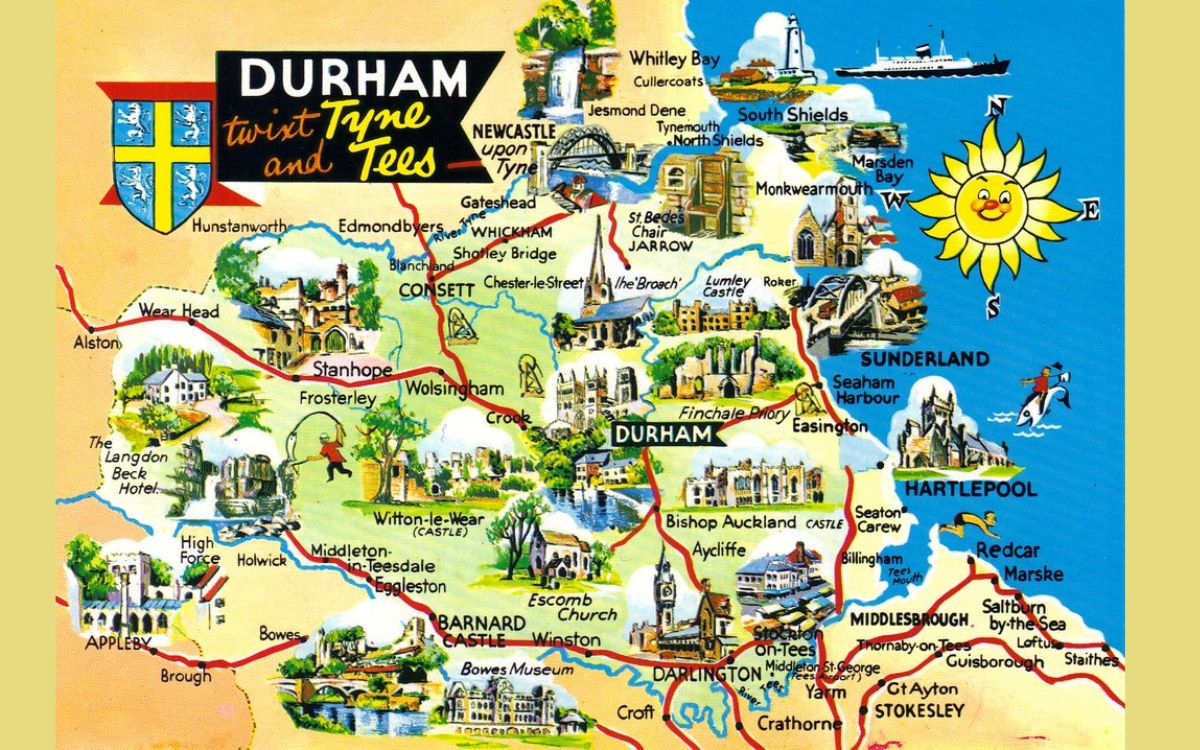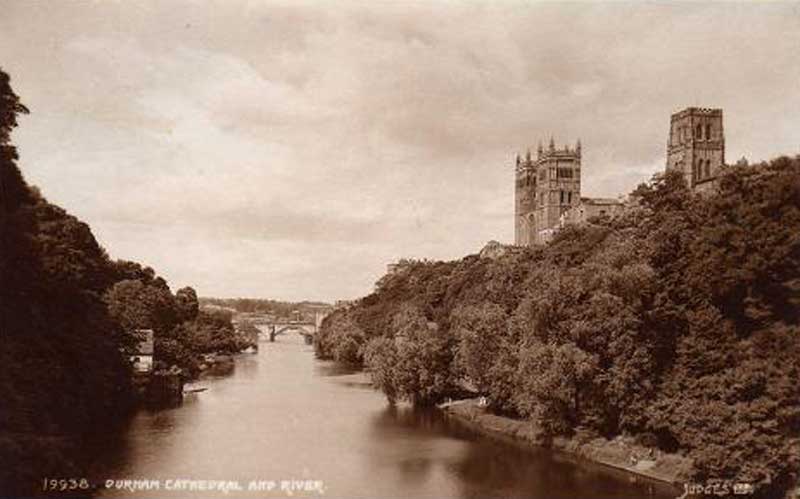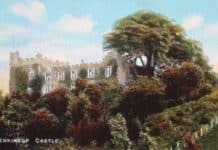Planning a spooky getaway to County Durham? Dive into our latest guide and craft your very own County Durham Ghost Tour, thanks to paranormal author and host of “How Haunted?” podcast, ROB KIRKUP

Create Your Own County Durham Ghost Tour
Many people log on to Spooky Isles when deciding what places they should visit for a haunted holiday. To make it easier, we’re creating “Create Your Own Ghost Tour” guides and put all the spooky stuff you’re going to want to visit in the one spot.
Author, ghost hunter and host of the “How Haunted?” podcast Rob Kirukp with his recommendations for your own ghost tour of County Durham.
History of County Durham
There is archaeological evidence of settlements within the area of County Durham dating back to 2000 BC. However, the present City of Durham, and the County that has grown around it, dates from AD 995 when monks from Lindisfarne settled on what was then known as Dunholme, as the final resting place of the remains of St Cuthbert.
During the medieval period the city found spiritual prominence and became the most important religious site in England, due to the remains of St Cuthbert being situated behind the High Altar of Durham Cathedral. It was claimed that the miracle healing powers of St Cuthbert in life had extended to death, as visitors to his shrine were said to be have been cured of all manners of diseases.
In the present day, the City of Durham is a wonderfully historic location with 569 listed buildings within the city centre. It is famed for the magnificent castle and cathedral which both date back almost 1000 years, and are jointly designated a UNESCO World Heritage Site.
Over the centuries the people of County Durham have borne witness to some incredible, and on other occasions horrific, occurrences, today this manifests itself in the haunted inns, castles, theatres, museums, abbeys, and even waterfalls, to be found in the county.
Spooky Places to Visit in County Durham
Lumley Castle was completed in 1398, and was the creation of the man from where it took its name; Sir Ralph Lumley. The 5-star hotel, it is today, is known the world over for it’s resident ghost Lily of Lumley. Lily was Sir Ralph’s wife, and when he was away two priests came to the castle to attempt to convert Lily to Catholicism, when she refused they murdered her and threw her body down a well. The priests then told Ralph that Lily had left to become a nun. Some say the ghost of Lumley rises up from the well every night, and roams the castle. Her footsteps are heard on landings, and even in hotel bedrooms.
The North of England Lead Mining Museum, better known as Killhope, is built around Park Level Mine which opened in 1853 to explore the rich veins of lead ore found at Killhope. The moors and dales of the North Pennines echoed to the sound of the lead mining industry for over fifty years until the mine ceased to operate in 1910.
Belief that the mine, the grounds, and the surrounding woodland, are haunted date back to when it was still a working mine. The miners were convinced that ghosts walked at Killhope, and used to call them Tommyknockers. Some of these ghosts were benign spirits that meant no harm, but it was commonly accepted that there were a number of evil phantoms, intent on causing disruption and misery.

Durham Castle, along with the breathtaking Cathedral, are very much icons of the city, and county, of Durham. The present castle was built in 1072 as one of the first fortified castles commissioned by William the Conqueror during his ‘Harrying of the North’.
One of the most memorable moments of a visit to Durham Castle is your first glimpse of the magnificent Black Staircase. It is named for the dark oak of which it was made, and is 57 feet high. It is one of the most impressive staircases of its time in England. What’s more, it appears that the Black Staircase may have a dark secret; the ghostly figure of a woman has been witnessed gliding up the staircase on countless occasions since the 17th century, her identity remains a mystery.
Bowes Castle stands on the original site of Lavatrae, a fort four acres in size built by the Romans in the Flavian period to protect the road across the Pennine Mountains. The fort was built in the 1st century and was occupied until the 4th century. Bowes Castle was built in 1136 as an earth and timber construction by Alan the Red, Count of Brittany, who also owned nearby Richmond Castle.
By the end of the 4th century the Roman occupation in England was coming to an end. The Roman garrison stationed at Lavatrae raided the local villages and stole all of their valuables, gold in particular. The furious locals retaliated and launched an attack on the fort, and despite putting up a brave fight, the garrison was quickly defeated and the Romans mercilessly slaughtered, having already hidden the plundered treasure.
On the anniversary of the massacre, the ghosts of the murdered Roman garrison are said to appear at Bowes Castle to ritually bury their stolen gold and treasure. However, those who see these spirits are said to die in mysterious circumstances before they can share the location of the buried gold.
Finchale Priory started life as a hermitage created by Godric in the early 12th century, and a club footed monk called Slewfoot is said to remain here today, depite the priory being in ruins. Timeslips are also reported here.
This is said to occur on the bridge next to Finchale Priory that crosses the River Wear and individuals have claimed to have seen Finchale Priory, no longer ruined, but how it would have appeared when it was in use as a priory, with monks wandering between the buildings. Witnesses have described sensations such as sounds appearing muffled, colours appearing muted, and a feeling of depression.
Haunted Places to Stay in County Durham
The Mercure Darlington King’s Hotel dates from 1611 and is the haunt of two ghosts called Mary and Albert who worked together at the hotel in the early 19th century.
Redworth Hall Hotel is a stunning Jacobean country house dating back to 1693, and a former lord of the house and a scullery maid, who was murdered after falling pregnant to this lord. Room 9 is particularly notorious.
Spooky Places to Eat and Drink
The Oak Tree Inn in Stanley was originally a manor built in 1690 for the Liddel family. It was opened as an inn in the mid 19th century and today is as charming as it is haunted. The best known spirit ois that of a man sat in the bar wearing a tricorn hat.
The Ancient Unicorn Inn in Bowes dates from the 16th century and visitors may encounter Emma. She died following the passing of her lover, who she was forbidden from being with, being seen as beneath him. Her sorry shade is still seen throughout the building that she knew so well in life.
Nearby Haunted Excursions
Cauldron Snout is a waterfall on the upper reaches of the River Tees, situated below a dam at the east end of the Cow Green Reservoir. Cauldron Snout is truly a breathtaking sight, the angry water rushing, bubbling, and crashing along a series of dolerite steps over 600 feet long. Vertically it is 200 feet from the first cataract to the last, meaning that Cauldron Snout is not only England’s longest waterfall, but also the highest.
The ghost of a Victorian farmgirl is said to haunt Cauldron Snout, her true identity is unknown but she is known locally as the Singing Lady. She was in love with a married lead miner and was broken hearted when he ended their affair. Devastated, she threw herself to the mercy of Cauldron Snout, cracking her skull on the rocks, and drowned
Her forlorn spirit is often seen gliding across the water on moonlit nights, witnesses have said that she appears to be crying, others say singing, but any noise she may be making is all but drowned out by the loud roar of the angry fast flowing water of Cauldron Snout.
County Durham is a wonderful part of the north east, and has all manner of historic locations worthy of your time. Not only that but the sheer number, and variety, of alleged haunted sites makes it a ghost hunters’ dream.
Have you visited County Durham for a ghost tour or made your own ghost tour itinerary? Tell us about it in the comments section below!
And please do tell us if we’ve missed something that you think we should add to this County Durham Ghost Tour Guide.
Find out more about Rob Kirkup and his work at The How Haunted? Podcast.
Listen to Spooky Isles Interview with Rob Kirkup
Recently, we spoke to paranormal investigator, author and historian Rob Kirkup about Ghosts of the North-East of England for our Spooky Isles: The Podcast. Please have a listen below and check out our other interviews with some very interestingly spooky people!








